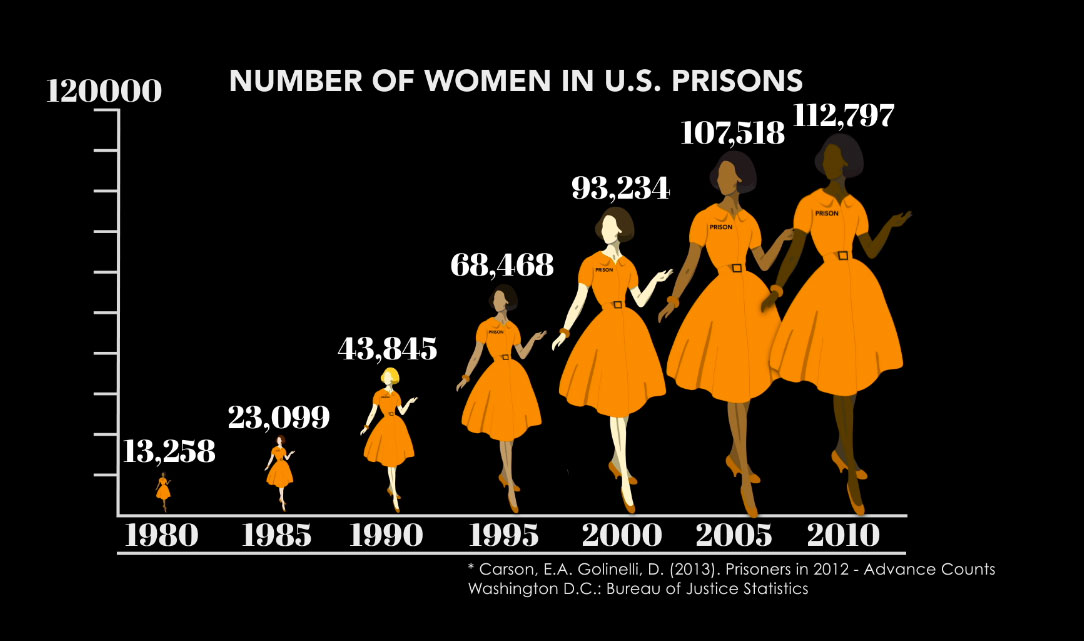


Men make up the vast majority of our nation’s prison population, roughly ten times the number as women, and commit the majority of crimes, particularly violence. Of the 200,000 plus women incarcerated in the United States, two-thirds are behind bars for a nonviolent offense, typically drug or property offenses.
For those women incarcerated for homicide, many acted in self-defense against abusive partners. Crystal Wheeler served 26 years for killing her husband, who had beaten her repeatedly and threatened her with a gun (as well as his employer). Inside a California prison, she met Brenda Clubine who had refused a plea bargain, adamant she had defended her life at the time she killed her estranged husband, who’d broken her bones and fractured her skull and had 11 restraining orders and a warrant for his arrest. Clubine founded the first inmate abuse support group in the nation, Convicted Women Against Abuse in 1989. Due to the efforts of CWAA, “Battered Woman Syndrome” (now called “Intimate partner abuse”) became an accepted defense in California in 1992.
The legislation they helped pass, however, didn’t help Crystal or Brenda. Both served more than two decades before legal advocates won their release. Other abused women languish in prison as efforts to free them go on for years.
Behind bars, women are at risk of sexual coercion at the hands of guards. Although they make up only seven percent of the state and prison population, women account for 33 percent of staff-on-inmate victims, according to the Bureau of Justice. In 2015 the Department of Justice investigating Alabama’s Tutwiler Prison for Women, found that more than one-third of prison staff – 36 of 99 employees – had sex with inmates. “Women prisoners at Tutwiler live in a toxic environment with repeated and open sexual behavior” the DOJ report stated, “forcing women to engage in sexual acts with officers in exchange for basic sanitary supplies. Male officers openly watch women shower or use the toilet … the sexual abuse and harassment is grossly underreported due to… a heightened fear of retaliation.”
Medical care in women’s prisons may be deplorable. Thirty-seven states will not tell pregnant inmates their due dates to prevent them from escaping, according to the Sentencing Project. The same number allows inmates to be shackled during labor and delivery.
In California, prison doctors performed forced sterilizations. In 2013 the Center for Investigative Reporting broke the story that 148 women, many of color, underwent tubal ligations from 2006 to 2010 in violation of prison rules and without required state approvals.
Girls in juvenile detention are even more vulnerable. The vast majority have suffered sexual or physical abuse at home and their health statistics behind bars are particularly grim: 41 percent have signs of vaginal injury consistent with sexual assault; up to a third have been, or are currently, pregnant, and eight percent have tested positive for tuberculosis, according to the National Girls Health and Justice Institute.



THE FACTS
Percentage of women convicted of homicide who acted in self defense against an abuser: up to 80
Solidarity
Percentage of increase in the numbers of women in federal and state prison between 1980 and 2010: 646
The Sentencing Project
Number of states that allow pregnant inmates to be shackled during labor and delivery: 37
ACLU
Percentage girls make up of all juvenile arrests for running away: 59
of juvenile prostitution arrests: 69
Princeton University
Percentage of incarcerated girls who have been exposed to physical, emotional or sexual abuse: 92
Princeton University
THE EXPERTS
Heidi Rummel
Co-Founder – Post-Conviction Justice Project
Professor – USC Gould School of Law
Gloria Steinem
Journalist and Activist
Presidential Medal of Freedom Recipient
Beth Adubato
Professor of Criminal Justice – New York Institute of Technology
ERA
Leslie Acoca
Founder – National Girls Health and Justice Institute
Dr. Martha Burk
Co-Founder – The Center for Advancement of Public Policy
THE RESOURCES
Battered Women’s Justice Project
http://www.bwjp.org
(800) 903-0111 ext. 1
National Clearinghouse for The Defense of Battered Women
www.ncdbw.org
(800) 903-0111 ext. 3
Prison Activist Resource Center
www.prisonactivist.org/resources/women
(510) 893-4648
